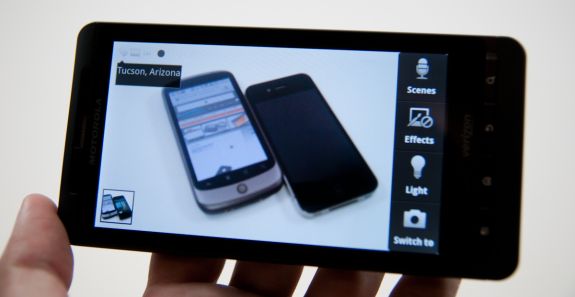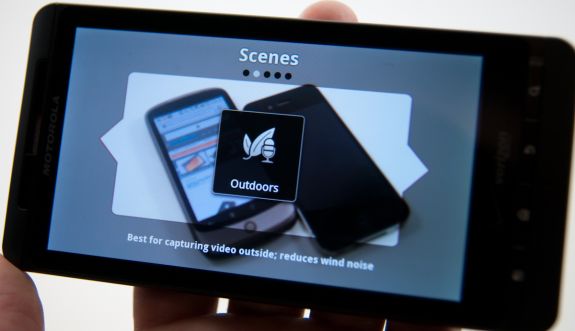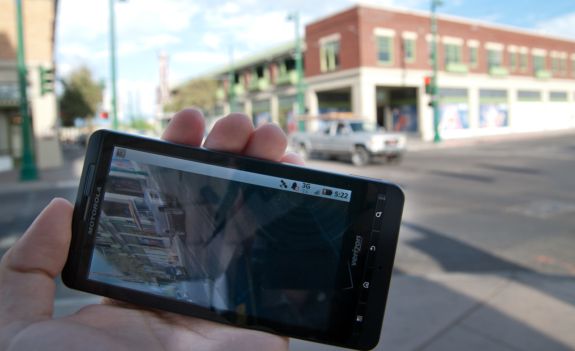Motorola Droid X: Thoroughly Reviewed
by Brian Klug on July 20, 2010 4:27 PM EST- Posted in
- Smartphones
- Motorola Droid X
- OMAP
- Mobile
Video
The X joins a number of smartphones shooting 720P video. It shoots 1280x720 video in MPEG-4 format at a full 30 FPS with AAC audio. This is up from the 24 FPS of the original Motorola Droid as mentioned earlier. Average video bitrate is nearly 1 megabyte/s. As expected, you can force the LED on and shoot video with illumination. 720P video capture is limited to 30 minutes at a time.
The layout of the video interface is virtually identical to the still interface. You can launch camcorder to get directly to shooting video, or just use camera for stills, or either one and switch between.
I found video quality to be almost as good as the iPhone 4’s, which is arguably the current leader. The EVO 4G’s video looks oversaturated and uses a noticeably worse audio codec, AMR narrowband. Though video bitrate is almost the same, I notice more blocking in the EVO 4G’s video than the X’s. I shot the X and EVO videos in the same hand at the exact same time, so feel free to do comparison on your own. Still, it’s hard to deny that the X’s video doesn’t look much more like what you’d expect, and the difference is all software and that SoC difference surprisingly.
Motorola Droid X
HTC EVO 4G
Nexus One
iPhone 4
HTC Droid Incredible
Motorola Droid
Nokia N900
The X also uses that three microphone array to do a lot of special noise canceling. The result is four different audio “scenes” for the user when in video mode. Everyday captures audio from every microphone, outdoors reduces wind noise, concert is for preventing microphone distortion and capturing loud music videos, narrative is for capturing videos while commenting on the scene, and lastly subject is for capturing video with audio from the front of the camera. I tried all of the audio scenes with the exception of subject, and found that they actually do a decently good job.
I’m impressed with how good of a job the narrative mode did - while shooting the video I couldn’t hear myself talk most of the time and didn’t expect much in the way of results. My test videos are the following:
Droid X - Outdoor Setting
Droid X - Narrative Setting
Droid X - Everyday Setting
Droid X - Concert Setting
Unless I’m mistaken, the X has the most microphones of any smartphone on the market, and I think Motorola has put some interesting use scenarios together with their five different sound scenes. It’s interesting that Motorola bills the X as a camcorder, dedicating a special application tile to camcorder over stills.
But that's not all, there's also video shooting modes that are a bit special, same as there were camera modes for stills. The X provides settings for slow motion and fast motion. When I saw the slow motion setting, I immediately suspected that higher framerate would come at the cost of video resolution. Really there are two reasons for that - pixel binning to gather enough light given a faster (shorter) integration time, and to keep the load on the SoC video encoder block the same.
As you'll see shortly, my suspicions were correct. Slow motion video is shot at 320x240 with no audio. Similarly, fast motion mode seems to reduce sampling but keep the encoded rate the same, similarly there is no audio in the file.
Droid X - Slow Motion Setting
Droid X - Fast Motion Setting
I did encounter one rather catastrophic crash while testing. After changing microphone effect modes, the camera preview went portrait, ditched all of the control interface, and refused to quit. After a minute of mashing the home button, I was able to finally get back to the home screen, but launching the camera again yielded the same thing. This all happened live, right where I was shooting test videos on the corner.
A reboot solved the whole thing, but perhaps this is something Motorola could take a look at fixing.














89 Comments
View All Comments
TareX - Thursday, July 22, 2010 - link
Why are all the Samsung Galaxy S phones missing from your charts and comparisons? I wanted to see how Hummingbird compared and how the Super AMOLED fared against their Droid X counterparts...strikeback03 - Tuesday, July 27, 2010 - link
Maybe because the first US version launched a day before the review went up, and they weren't sent a review sample.enealDC - Thursday, July 22, 2010 - link
Great job!Juniper Research - Friday, July 23, 2010 - link
Very interesting article... we have this week published a new report on smartphones and a free whitepaper is available to download here... http://www.juniperresearch.com/reports/next_genera...John Levett
Marketing Executive at Juniper Research
Homefries - Saturday, July 24, 2010 - link
First off, great review Brian.However, while you did a very thorough comparison of the Droid X to other Android devices, you barely mentioned the real competitor the Droid X has to stand up against: the iPhone 4.
Readers want to know if the Droid X is the best phone on the market - the whole market - not just the market subset dedicated to Android devices.
Like the majority of the tech media, your review furthers the notion readers belong exclusively to either the iOS camp or the Andriod camp. This is simply not true. Informed readers, like the ones that peruse Anandtech, want to buy one smartphone, regardless of any marketing slants, that is the best.
Your review of the Droid X should have helped us answer the question, "Should I buy the Droid X or the iPhone 4?" But, it did not.
strikeback03 - Tuesday, July 27, 2010 - link
Well, I think the conclusion in the iPhone article and some earlier Android articles applies, there is no "best" for everyone. Some people love Apple and the Apple way of life, some people won't touch it. As the iPhone is currently limited to AT&T, that is going to deter a lot of people. How large a pocket/bag you plan on carrying the phone in might make size differences more important to some than others. So while I am not one of the readers calling for no subjective opinions (it is interesting that FroYo feels significantly faster/different) I think it is still up to each buyer to decide what is most important to them.Electrofreak - Saturday, July 24, 2010 - link
Brian and Anand, are you sure you're using the correct information regarding the SoC in the Droid X? I believe it is a OMAP 3640, not a 3630, as the maximum recommended clock speed of the 3630 is described in numerous places across the net as being 720 MHz, while the max clock speed of the 3640 is described as 1 GHz. In addition, the max recommended clock speed of the 3430 in the Droid was 600 MHz, not 800.The information I cite above is widely available across the web... if you've got inside information the rest of us don't have, by all means let us know. But as someone who has written articles of my own on ARM SoCs and follows ARM industry news closely, I suspect that your data may not be 100% correct.
Regardless, I do have to thank you for writing some of the most informative hardware articles on the net. I appreciate it!
Electrofreak - Saturday, July 24, 2010 - link
...and I just found this: http://e2e.ti.com/blogs_/b/mobile_momentum/archive...So, per TI's blog it is the 3630... now we just need an explanation of the other info on the web that describes the 3630 as maxing out at 720 MHz.
Brian Klug - Monday, July 26, 2010 - link
Yeah, TI's documentation is a bit outdated. Anand tackled the SoC part, but the 3630 is indeed a 1 GHz part, it isn't the 3640 guaranteed. There was a lot of confusion online about it, but Anand got the official word. ;)I agree, back when I did my other OMAP 3 piece it was 720 MHz.
-Brian
Electrofreak - Saturday, July 24, 2010 - link
Looking forward to that Hummingbird review Brian. I hope you're able to dig up some info that I wasn't able to when I wrote my article (http://alienbabeltech.com/main/?p=17125) back in April.